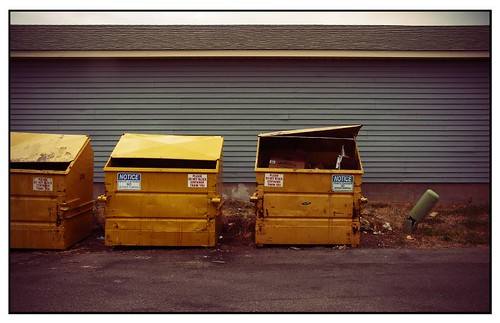We’ve been cleaning out a bit lately at the Public Theatre. One reason is we’re about to undergo major construction and renovation, and need to clear out spaces that haven’t been cleared out in decades. Another reason is we finally have all our shows open for the year and have a bit of a breather at the moment. Finally, storage space is expensive in New York City, and we don’t have that much to begin with, so we continually need to reevaluate what we keep.

Like most props people, I’m a bit of a pack-rat, so it can be almost physically painful to throw things out. There are of course, alternatives to just trashing things. The easiest solution, depending on the item, is to send out an email to everyone in your theatre and offer it up for free on a first-come first-serve basis. You can also try to sell it on Craigslist or eBay, or through another venue. There are also a number of charities you can donate certain things to, such as Salvation Army or Goodwill. Here in New York City, we also have a place called Materials for the Arts.
So how do you go about determining what to keep and what to toss? Unfortunately, no two theatres can use the same set of guidelines. If you do mainly new works, you’ll have different prop needs then if you do mostly Shakespeare. Likewise, the capabilities of your shop will determine what props can be built in the future. While you may come across your own set of guidelines after maintaining a storage space for a few years, if you’re new to your stock, you can run through a series of questions to determine whether a prop is trash or treasure.
How show-specific is the prop? Is it something common that can be used in a number of shows or as a rehearsal prop? Or is it a painting of a unicorn on a piece of black velvet… in a forced perspective picture frame.
How large is it? If it takes up the space of several smaller props, you may need extra justification to keep it around.
How much does a new one cost? If it’s inexpensive, especially if it’s already showing some wear and tear, you may want to just buy a new one when you need it… that is, if you need it.
How hard would it be to build another one? Some props are constructed so simply, it would almost take more time to walk to the prop storage, dig around until you find it, and carry it back, then it would to build a new one. This is especially true when I come across props whose construction can be improved upon.
Do you already have some of the same thing in stock? Sometimes you need multiples, but sometimes there’s no conceivable reason why you would need a hundred brown paper grocery bags; and if you did, you should demand the budget for it.
Is the item in good condition? You have to figure that anything in your stock will need some tightening and dusting when you pull it out, but if it’s beyond repair, why are you keeping it?
Is there anything useful or valuable that can be taken off and used again? If you can remove large, sections of usable raw materials, do it. Sometimes, you have pieces which you feel can be incorporated into future props, such as knobs or dials. In these cases, I’d rather keep these “found object” building materials with the rest of the building materials; keep knobs with knobs, dials with dials, and the rest in containers such as “brass stuff” or “wood pieces”. It’s a lot easier than filling your prop storage with random vacuum cleaner parts and broken prop pieces.
Is it going to be difficult or dangerous to store? We all have at least one prop like that in our storage; no matter what we need to get, it always seems to be in the way some how, and it weighs more than you can lift. No matter where you put it, you’re doomed to be kicking a dead horse whenever you need to get a chair.
How adaptable is it? Chairs can always be reupholstered, refinished, or painted; they can even be made taller or shorter. Compare that with a carved piece of solid marble.
Will it attract mice and ants in storage? I’m looking at you, shellac-ed piece of real bread.
How well-made is it? This is a little different from whether it’s in good shape or not. A crude and ugly piece is still crude and ugly even when it’s undamaged. An exceptional prop, in addition to serving your limited storage well, can also have instructional value for future prop building endeavors.
Can you make money or develop karma by renting it out to other companies? If you have an iron lung, you can almost make a full-time job out of renting it to theatres who are putting on “City of Angels”.
I’d love to hear what everyone else does to determine what to keep and what to get rid of, as well as more alternatives to simply throwing things away.




